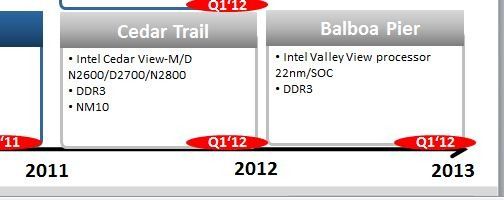As Intel continue to craft Atom into the phone and tablet market it makes sense that they explore all avenues for the core. The ‘netbook’ wave is over but that doesn’t mean there aren’t spaces for Atom to be fitting into. Low cost and low power computing is one of them. Open-source computing is another and it looks like Intel is heading in all of these directions with the Balboa Pier platform and the Valley View Atom/HD graphics SoC inside it.
The Verge have pulled together some good information sources on the new platform.
Being a 22nm SoC, it’s going to be small. There are going to be 1-4 core variants and it 4x the graphics performance that looks like it’s going to be based around Ivy Bridge.
You can track through all the links at The Verge for more information but I wouldn’t get too excited about this appearing in laptops just yet. The main source here is an industrial module manufacturer so we could be talking about an embedded solution. It’s a Q1 2013 solution too. It would, however, make some sense to offer a low-cost PC platform with open-source graphics drivers, something that the Ivy Bridge in-house graphics would enable. That would open up the platform to Chrome OS and other Linux-based PC solutions. It might also help Android open-source solutions on X86. Netbooks for the emerging markets could be a target too.
Without a TDP figure it’s difficult to work out if this could go into Windows 8 tablets and where it sits against Clover Trail W but considering Sandy Bridge has already worked its way into the Samsung XE700, why not. 4-cores are needed in the tablet sector just for the marketing teams!












It’s a old slide from 2010 Chippy,aside from 2010 being the start of the chart note the color code on the full chart shows Sandy Bridge as still being in development and Cedar Trail as only in planning stage.
So Balboa should actually be referring to what we now call Silvermont.
Am not excited for this until they talk about cooling issues
Cooling issues? ATOM’s are low powered and even the existing 32nm solutions are running pretty cool.
The Asus Eee PC X101CH with N2600 3.5W TDP for example is a fan-less netbook and both the Eee PC 1025C and Eee PC 1025CE were so quiet that at least one reviewer mistakenly thought they were fan-less as all he heard was the hard drive clicking.
Even the nettop/desktop D-Series Cedar Trail ATOMs only go up to about 10W max TDP. Well below what is typical of a regular laptop and even ULV processors.
While the 22nm SoC’s should run even cooler, especially those versions that will be directly marketed to compete with ARM solutions in the mobile market. Though models designed for higher performance may still run warm enough to still require fans but those will be mainly for nettop/desktop/servers and may still go fan-less with a large enough heat sink.